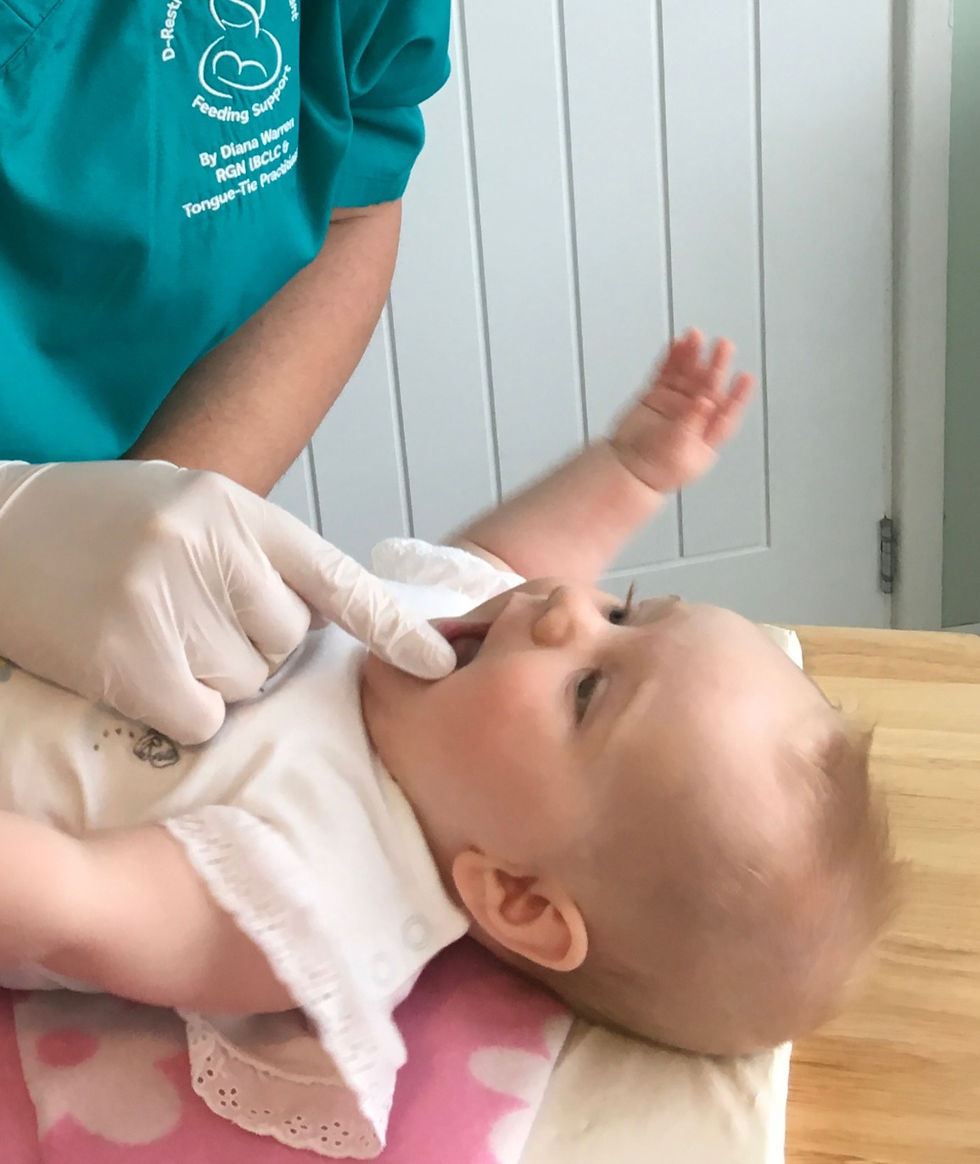Posterior Tongue-Tie Restriction
- Diana Warren RGN, IBCLC, Tongue-tie Specialist

- Aug 10, 2022
- 4 min read
Updated: May 1, 2024
Posterior Tongue-Tie Restriction
(the one that is easily missed!).
Traditionally, the only ties that were thought to cause any problems were the anterior ties. Visually obvious, all the way to the tip of the tongue and attached to the alveolar ridge (gum line) at the bottom-who could get that wrong?!
We now know that it really isn't about what the tongue looks like, its about its function. What it can and can not do that counts. Certainly in practice I have seen anterior ties that have a good height, thin and stretchy and do not pose any restriction on tongue function at all. Similarly, I have seen very short, and thick posterior ties that cause every feeding problem known to (wo)man. and lets face it, its not like behind an anterior tie there is a gap!-it continues through to the posterior area of the tongue.

Posterior Tongue Tie Restriction Definition:
There is no universally agreed definition of the area that I refer to as 'a posterior restrictive tie'. Unfortunately, this leads to much confusion, as a medical professional may conclude that the posterior element is buried deep within the tongue muscles (geniogolossus) itself, which fuels the advice that 'posterior ties do not need dividing', whereas another would not include the area in the muscle itself, and another believes only the restrictive element would warrant a division (how can that even be determined?).
Now I agree that we do not need to go furkleing deep within the muscle itself-that may cause more damage, including potentially in the longer term too!
When I suggest a posterior restriction, I am referring to the frenulum that protrudes forwards of the tongue muscle. The posterior element of this would be the final 25% of the frenulum before the area that attaches to the root muscle (geniogolossus). So an anterior tie is 100% of the way/length forward, and a posterior just the final quarter. Not all healthcare professionals assess in this way, there are differences, but as I say its more the function and symptoms that count rather than appearance. Many qualified professionals would also use a scoring tool to help reduce the chance of over-diagnosis. A tool combined with a feeding assessment, tongue motility assessment and noting of adverse symptoms would provide an holistic approach to the matter in hand.
What to look out for?
Well, the short answer to this, is to look for exactly the same as you would in an anterior tie-look at the feeding symptoms and try not to focus on the visual appearance.
Symptoms for any restrictive tie may include:
(*Feeding symptoms may not associated with a restrictive tie at all, it may be another issue, it really is about seeking professional support and assessment of tongue function)
Weight gain/loss
Breast milk supply issues
Painful feeds
Dribbling milk
Tiring during an active feed
Not maintaining a seal/latch (teat or breast)
Noisy feeding
Crushing teat with gums
Piston action on a dummy/bottle (like Maggie Simpson!)
Poor flow control of the milk
Sensitive gag reflex
Shallow latch onto breast or teat
Frustration or anger to feed
Feeding aversion
Breast duct blockages/ blebs/ mastitis
Thrush
Trapped wind / colic
Reflux/Silent reflux
Who Can assess for a tongue tie restriction?
This is where it gets complicated. Very few medical professionals in the grand scheme of things are trained in the diagnosis and division of a tongue tie. In the UK, there are currently 2 main training centres only. Practitioners have to be registered with CQC England, and be regulated as a nurse, doctor, dentist or health visitor. Unfortunately, many are giving diagnosis such as 'mild' , 'slight' or 'severe' which is an opinion NOT a diagnosis-and very ambiguous terms too-what does 'mild' even mean? thin? short? posterior? it s all very confusing for the caregiver.
It is not part of routine midwifery, health visitor, or GP training.
There are many healthcare professionals who are experienced in recognising a tongue tie restriction, and very often get it correct-but they are not trained to provide that diagnosis. Instead, my preference would be that they tell you it is suspected, and then refer to someone that may be able to assess, such as an IBCLC (International Board Certified Lactation Consultant) or a member of your local infant feeding team. Many UK based tongue-tie practitioners are members of The ATP (Association of Tongue Tie Practitioners) and many choose to list their services with them, so you as a parent then also know that they are trained professionals, and can locate where they are based based on a postcode search www.tongue-tie.org.uk. (The ATP are not regulators, so it remains within the caregiver's responsibility to check an individuals credentials). Similarly, you can check with their individual regulators on an online search or through CQC England too www.cqc.org.uk.

To conclude:
If you suspect, or you're not sure-seek a trained professional who can assess. If it is not a restriction, then they should still be able to support you to achieve your feeding goals and work towards rectifying any other causes of feeding complications.









Comments